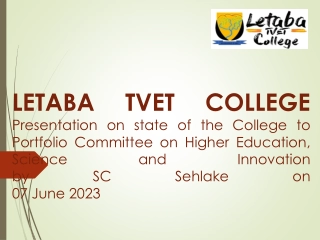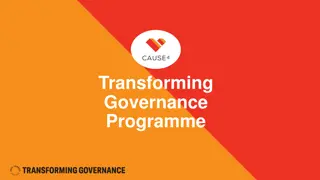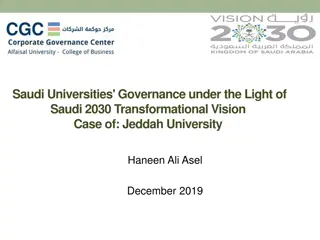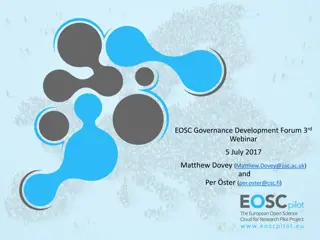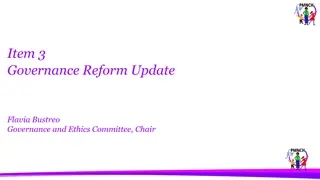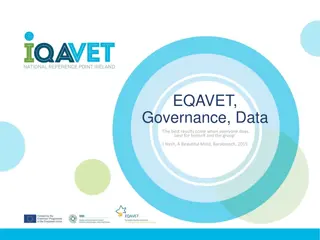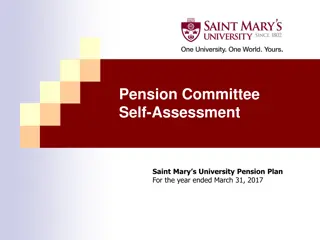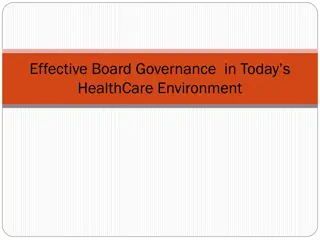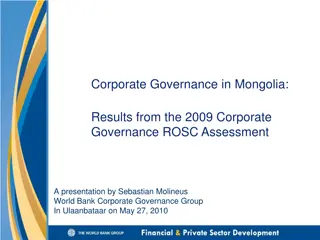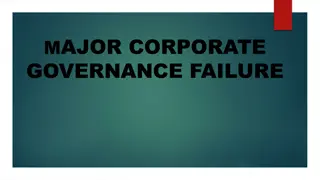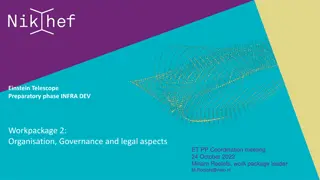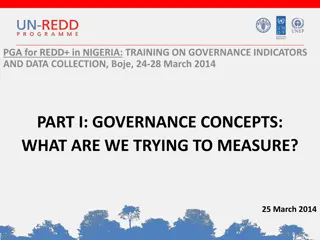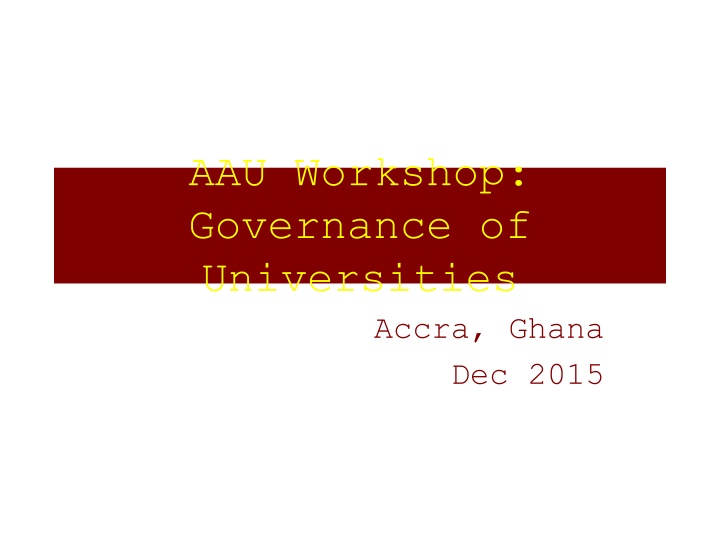
Governance in Higher Education Institutions
Explore the key concepts and considerations surrounding governance in higher education institutions, delving into topics such as institutional autonomy, academic freedom, accountability, and more. Discover the multi-element and systemic perspectives on governance for sustainable improvement in the educational sector.
Download Presentation

Please find below an Image/Link to download the presentation.
The content on the website is provided AS IS for your information and personal use only. It may not be sold, licensed, or shared on other websites without obtaining consent from the author. If you encounter any issues during the download, it is possible that the publisher has removed the file from their server.
You are allowed to download the files provided on this website for personal or commercial use, subject to the condition that they are used lawfully. All files are the property of their respective owners.
The content on the website is provided AS IS for your information and personal use only. It may not be sold, licensed, or shared on other websites without obtaining consent from the author.
E N D
Presentation Transcript
AAU Workshop: Governance of Universities Accra, Ghana Dec 2015
Our programme (final programme will be distributed closer to the date)
Some key concepts Institutional autonomy Academic freedom Accountability Authority Responsibility Transparency Alignment Governance Access Relevance Quality Success Optimal M-E-I flow
Corporate Governance a definition The system by which corporate entities: exercising accountability to shareowners and responsibility to stakeholders are directed and controlled to achieve sustainable improvement in shareowner prosperity (KPMG)
Key considerations for HEIs Can HEIs be classified as corporate entities? Who are their key shareowners? How does the goal of shareowner prosperity applies to HEIs? Is governance in its most fundamental form different to an appropriate enlightened self- interest ? Does sound HEI governance build on the principles of Integral theory?
(Epistemology) Ontological levels of behavior Expansiveness/inclusiv e shareholders/stakehol ders perspective Expansiveness of HEI s worldview
Governance: a multi-element perspective
Governance: Multi-element definition
Governance: Systemic perspective The why is question The how well is question The what is question The how is question (dynamic multi-directional MEI flow M= flow of matter, E= flow of energy (normative and strategic leadership), I= flow of information)
Sound governance: a prerequisite for Sustainable Competitive Advantage (Rothhaermel, 2013)
University, Organization, Governance and Competitiveness (PPT 10-12: Lombardi, Craig, Capaldi & Gater, Aug 2002))PP Community engagement
Embedded in a broader institutional context . (Lombardi, Craig, Capaldi & Gater, Aug 2002)
Institution embedded in macro systems context M I E
At the heart of it all: ensure sustained composite quality
Fundamental The dynamic tension between institutional autonomy and academic freedom Where is the tipping point: is it benefiting to and rewarding for society to allow HEI institutions to govern themselves and to decide on the central questions: Who to teach What to teach How to teach When to teach (based on SASCO Discussion document, 2009)
Institutional autonomy High degree of self regulation and administrative independence with respect to: student admissions, curriculum, methods of teaching & assessment, research, establishment of academic regulations and the internal management of resources generated from private and public sources (Higher Education White Paper, 1997)
Institutional Autonomy implies Freedom of government regulation iro: Internal organization Its governance Internal management of financial resources In generation of income from non-public sources Recruitment and appointment of its staff Conditions of study Its teaching and research Summarized: HEI s should be autonomous from government and political control Question: Autonomy from business, donors, sponsors and other sectors of society? (Higher Education White Paper, 1997)
Institutional autonomy implies.. HEIs should be accountable to society at large society: totality of such sectors and sections as communities, business, labour, government, church, social movements and other organized forms Warning: High level of institutional autonomy not necessarily a guarantee for high level of academic freedom (Higher Education White Paper, 1997)
Academic Freedom Freedom of teachers, students and academic institutions to pursue knowledge wherever it may lead, without undue or unreasonable interference. As a minimum, freedom to: Engage in the entire range of activities iro production, of knowledge Choosing a research focus Determining what to teach in the class room Presenting research findings to colleagues Publishing research findings
Prerequisites for Academic Freedom Recognizing intellectual independence means protection of students and faculty from imposition of political, religious or ideological nature Preventing academics from taking unfair advantage of students Promoting inquisition of the knowledge system Forbidding indoctrination of any kind (Higher Education White Paper, 1997)
State and Academic Freedom President Kwame Nkrumah: if reforms do not come from within, we intend to impose them from outside and no resort to the cry of academic freedom is going to restrain us from seeing that our university is a healthy university devoted to Ghanaian interests (Higher Education White Paper, 1997)
State and Academic Freedom President Robert Mugabe: Higher education is too important a business to be left entirely to deans, professors, lecturers and university administrations Assumption: Governments and states legitimately acting on behalf and in interest of society as a whole (Higher Education White Paper, 1997)
Two of the key actors: The University Council and the VC Systems challenge: as key enabler for appropriate governance how to optimize multi-directional MEI-flow between Council and VC The Chairperson of Council/Counc il The VC MEI: M = flow of matter (resources); E= flow of normative oversight; I = flow of appropriate and constant levels of information
Panel discussion: VCs How do VCs view their role in context of the University Council What do they consider as major positive attributes of their interaction with Council What do they consider as major challenges iro their interaction with Council
From previous panel discussions CoC is VCs immediate line manager VC the prime example of servant leadership VC s legislative empowerment need for sound delegation without abdication VC s total: accountability as outlined by the relevant legislation Principles of entrustment, total transparency and honesty, ongoing dialogue, Need for consultative partnership
From previous panel discussions Challenges: balancing act, council members with vested interests, uninformed council members, clear demarcation of roles, micro management, VC reducing Council to rubber stamping , Politics, triangulation, VC on the anvil between Council and rest of University community? Clarity: Roles, rights and obligations as stipulated by law Council members serving on University Committees? Alignment: Institutional Vision and VCs vision, envisioning of Council members Context very important: Public vs private universities
Role and function of the VC To develop and recommend to the Council the strategy and vision for the HEI Develop and recommend to the Council annual business plans and budgets To achieve the HEI s systemic goals and objectives and to ensure sound operational management of the HEI To ensure the sustainable competitive position of the HEI Ensure that the HEI has an effective management team Formulate and oversee implementation of major corporate policies The chief public persona of the HEI
The HEIs Council as the pivotal governance structure Ultimately responsible and accountable* for: ensuring that the HEI is sustainable that it fulfills its accountability to society. finally accountable for full and effective regulation of the HEI therefore it must direct and regulate the VC and his/her management team and ensure that it is involved in all material decisions affecting the HEI *
Panel discussion: CoCs and Councils How do CoC s view their role relevant to that of the VC and his/her management team What do they consider as major positive attributes of their interaction with the VC and his/her management team What do they consider as major challenges iro their interaction with the VC and his/her management team
Generic Governance issues Council relationships with Management The roles that the VC and executive level managers should play as members of university councils How best to balance the shared responsibility for executive manager development between the Council and the VC How to gain the insights of other senior managers at the HEI as advice and inputs for the Council How to ensure Council s unfettered access to management How to expand non-executive Council members insight re the HEI s operations,
Generic Governance issues Council relationships with Management Monitoring and overseeing VC and executive management: Reliable and timely system of performance management Establishing appropriate level of detail to be provided To consider both short and longer-term performance To avoid VC and executive management domination of Council discussions How to gain direct information from managers reporting to VC and executive level managers
Role and function of the Chairperson of Council Providing overall leadership to the Council Actively participating in selection of Council members (is this possible?) Arrange appropriate induction of new Council members Monitoring and evaluating Council s performance In conjunction with VC and Registrar, developing annual work plan for Council Main information link between Council and VC/management
Role and function of the Chairperson of Council Enough time for discussion at Council meetings Maintaining, in conjunction with VC, sound relationships with key HEI stakeholders Ensuring that all Council members play a constructive role in the affairs of the HEI Ensure that the Council receive timeous and relevant info in order to be able to make informed decisions
CoC Panel discussion Synergistic value adding partnership Council approved decisions providing umbrella of security for VC Intimate knowledge of University conducive to good interrelationships Prerequisite to maintain your independence and not to be co-opted Council members opening doors for Fundraising Length of term of membership Avoid dangers of triangulation Promote Council stability change of government not necessarily affects composition of Council
CoC Panel discussion VC: one leg raised, two bags packed Pre-work via Committees of Council Relevant, nimble footed, treat University as a business Regulatory/ legislative framework know your sources and understand your duties, rights and obligations as well as accountabilities with legal implications Beware the governance tripod Council mainly normative and strategic, but with situational approach Council s role iro Common Law (good faith and care) as well as the moral imperative (acting in interest of the country)
AUF-ACU Partnership: on Governance Two approaches to tackle the problems of higher education institutions governance in Africa It consists of rationalizing, valorizing and modernizing both the university foundations and their various systems of functioning It supposes to put on better the whole university structure : better management, transparency in the decision-making and the participation of all actors in the decision-making The second approach of governance fundamentally questions efficiency of systems of functioning of universities, too much centered on the hierarchical authority of the State, and on that of the university and academic administration, whether it is to define the financing, programs, the qualifications and even the courses of training The governance of higher education will succeed only if it allows creating a common space of
Some viewpoints Moodie & Eustace, 1974 Jarrat Report, CVPC, 1985
Some more viewpoints. (Shattock, July 2002)
On Shared governance (Shattock, July 2002)
Questions to consider Creating a common space where the various actors in governance can work concurrently on optimal governance of the HEI To have a meeting of the minds /perceptions of the various actors To consistently strive for optimal value adding by all of the actors To get the balance right: maintaining a dynamic creative tension between academics (Senate?) and the Council Locus of improprieties breakdown between Governing Bodies and HEI executives (it can be be very toxic and extremely detrimental to the HEI) how do we avoid this? How do we enhance a positive dialogue between the Governing Body and academia are Academia fit for this purpose (structure, composition, its strategic agenda, etc). What can the VC do in this regard? How do we utilize the best of the corporate as well as collegial approach in a shared governance model for the HEI (sustained by a shared common purpose for the HEI) Is there still room for a collegial approach that underpins appropriate governance of a 21st century HEI?
Understanding the Governance Iceberg Symptomatic challenges Fundamental root causes
Small Group assignment with feedback in plenary sessions What do your group consider as the fundamental root causes of governance challenges experienced between the Governing body and the University s VC/ executive management team What are your max 5 recommendations to, in a systemic manner effectively treat these root causes
Group feedback Each group to appoint a spokesperson Spokesperson to do a max 10 min presentation on root causes as identified by the group as well as on recommended systemic treatment of these root causes Group presentations will be followed by open discussion in plenary session
Conclusions/summaries from previous workshop Highlighted the pivotal roles of the Chairperson of Council and the VC Notion that their leadership should be : both output (task) and people orientated Should be anchored and empowered both in the legislative, regulatory sources as well by a strong moral compass focused on the systemic positioning of the HEI as good, truthful, wealth creating and aesthetically pleasing The behavior of all the actors should be in terms of shared values, with strict application of Codes of Conduct The principle of concurrent involvement The strong need for effective and efficient Council Committees Composition and skills diversity extremely important Council included in joint strategy sessions
Understanding the HEIs unique business model as a guideline for appropriate Governance
Government Students Staff Council Alumni Communities Donors Sponsors Shareholder/stakeholder pointers for systemic corporate governance

